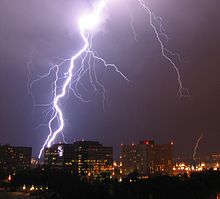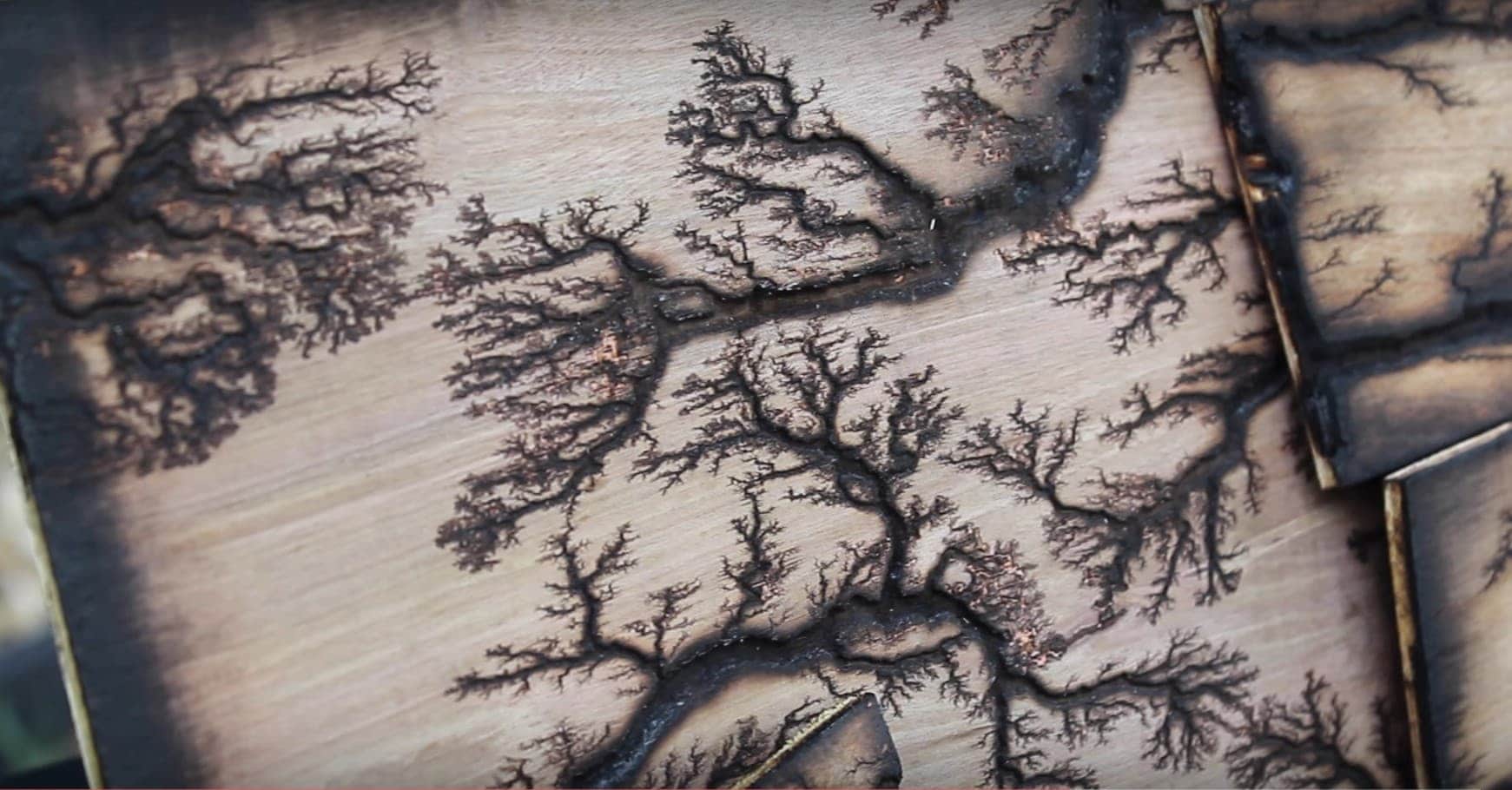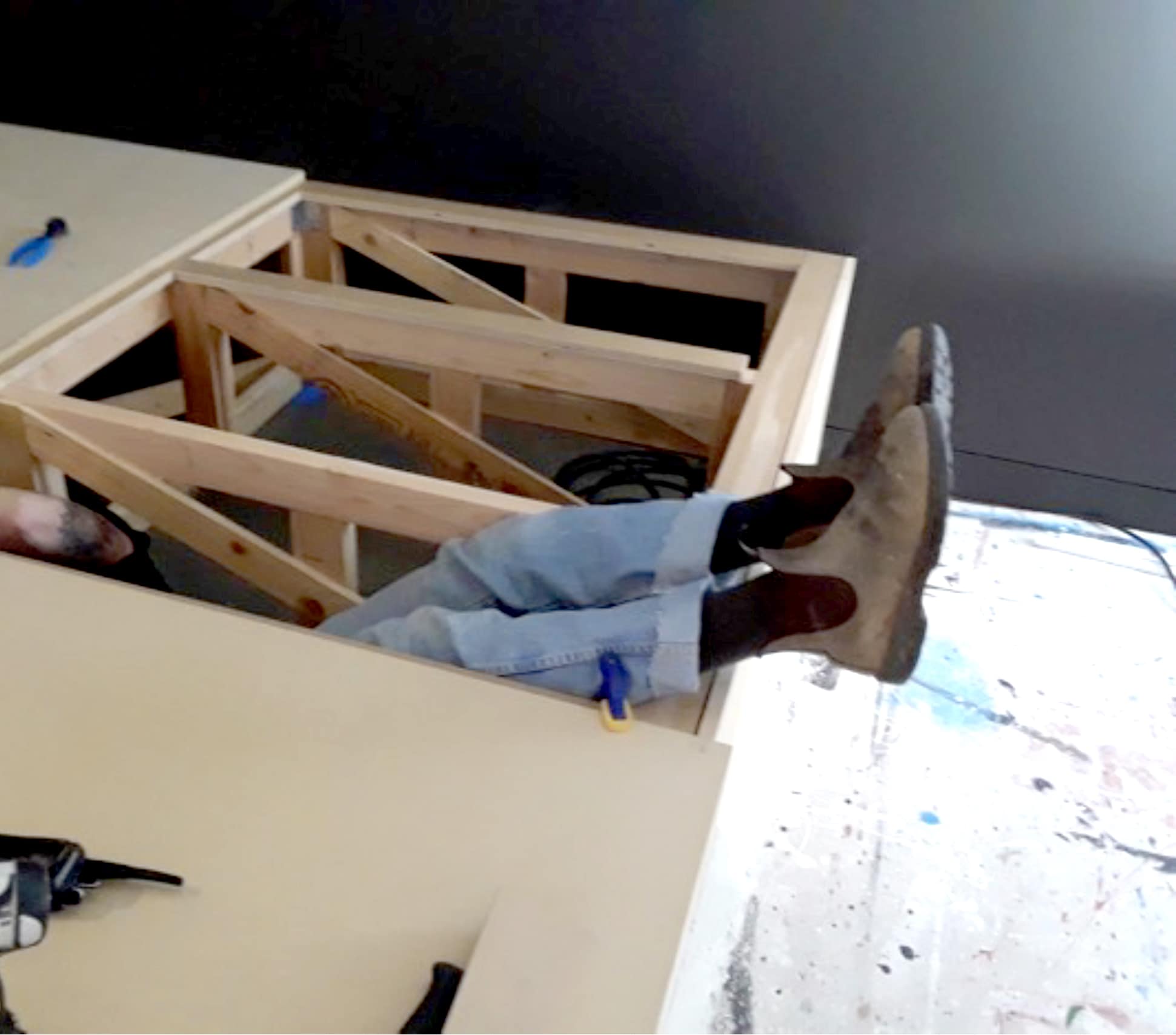Lichtenberg figures (German Lichtenberg-Figuren), or “Lichtenberg dust figures”, are branching electric discharges that sometimes appear on the surface or in the interior of insulating materials. Lichtenberg figures are often associated with the progressive deterioration of high voltage components and equipment. The study of planar Lichtenberg figures along insulating surfaces and 3D electrical trees within insulating materials often provides engineers with valuable insights for improving the long-term reliability of high voltage equipment. Lichtenberg figures are now known to occur on or within solids, liquids, and gases during electrical breakdown.
History
Lichtenberg figures are named after the German physicist Georg Christoph Lichtenberg, who originally discovered and studied them. When they were first discovered, it was thought that their characteristic shapes might help to reveal the nature of positive and negative electric “fluids”. In 1777, Lichtenberg built a large electrophorus to generate high voltage static electricity through induction. After discharging a high voltage point to the surface of an insulator, he recorded the resulting radial patterns by sprinkling various powdered materials onto the surface. By then pressing blank sheets of paper onto these patterns, Lichtenberg was able to transfer and record these images, thereby discovering the basic principle of modern xerography.
This discovery was also the forerunner of the modern-day science of plasma physics. Although Lichtenberg only studied two-dimensional (2D) figures, modern high voltage researchers study 2D and 3D figures (electrical trees) on, and within, insulating materials. Lichtenberg figures are now known to be examples of fractals.
Formation
Two-dimensional (2D) Lichtenberg figures can be produced by placing a sharp-pointed needle perpendicular to the surface of a non-conducting plate, such as of resin, ebonite, or glass. The point is positioned very near or contacting the plate. A source of high voltage, such as a Leyden jar (a type of capacitor) or a static electricity generator, is applied to the needle, typically through a spark gap. This creates a sudden, small electrical discharge along the surface of the plate. This deposits stranded areas of charge onto the surface of the plate. These electrified areas are then tested by sprinkling a mixture of powdered flowers of sulfur and red lead (Pb3O4 or lead tetroxide) onto the plate.
During handling, powdered sulfur tends to acquire a slight negative charge, while red lead tends to acquire a slight positive charge. The negatively electrified sulfur is attracted to the positively electrified areas of the plate, while the positively electrified red lead is attracted to the negatively electrified areas. In addition to the distribution of colors thereby produced, there is also a marked difference in the form of the figure, according to the polarity of the electrical charge that was applied to the plate. If the charge areas were positive, a widely extending patch is seen on the plate, consisting of a dense nucleus, from which branches radiate in all directions. Negatively charged areas are considerably smaller and have a sharp circular or fan-like boundary entirely devoid of branches. Heinrich Rudolf Hertz employed Lichtenberg dust figures in his seminal work proving Maxwell’s electromagnetic wave theories.
![]()
Carbonized high-voltage discharge tracks cross the surface of a polycarbonate sheet
If the plate receives a mixture of positive and negative charges as, for example, from an induction coil, a mixed figure results, consisting of a large red central nucleus, corresponding to the negative charge, surrounded by yellow rays, corresponding to the positive charge. The difference between positive and negative figures seems to depend on the presence of air; for the difference tends to disappear when the experiment is conducted in vacuum. Peter T. Riess (a 19th-century researcher) theorized that the negative electrification of the plate was caused by the friction of the water vapour, etc., driven along the surface by the explosion which accompanies the disruptive discharge at the point. This electrification would favor the spread of a positive, but hinder that of a negative discharge.
It is now known that electrical charges are transferred to the insulator’s surface through small spark discharges that occur along the boundary between the gas and insulator surface. Once transferred to the insulator, these excess charges become temporarily stranded. The shapes of the resulting charge distributions reflect the shape of the spark discharges which, in turn, depend on the high voltage polarity and pressure of the gas. Using a higher applied voltage will generate larger diameter and more branched figures. It is now known that positive Lichtenberg figures have longer, branching structures because long sparks within air can more easily form and propagate from positively charged high voltage terminals. This property has been used to measure the transient voltage polarity and magnitude of lightning surges on electrical power lines.
Another type of 2D Lichtenberg figure can be created when an insulating surface becomes contaminated with semiconducting material. When a high voltage is applied across the surface, leakage currents may cause localized heating and progressive degradation and charring of the underlying material. Over time, branching, tree-like carbonized patterns are formed upon the surface of the insulator called electrical trees. This degradation process is called tracking. If the conductive paths ultimately bridge the insulating space, the result is catastrophic failure of the insulating material. Some artists purposely apply salt water to the surface of wood or cardboard and then apply a high voltage across the surface to generate complex carbonized 2D Lichtenberg figures on the surface.
Fractal similarities
The branching, self-similar patterns observed in Lichtenberg figures exhibit fractal properties. Lichtenberg figures often develop during the dielectric breakdown of solids, liquids, and even gases. Their appearance and growth appear to be related to a process called diffusion-limited aggregation (DLA). A useful macroscopic model that combines an electric field with DLA was developed by Niemeyer, Pietronero, and Weismann in 1984, and is known as the dielectric breakdown model (DBM).
Although the electrical breakdown mechanisms of air and PMMA plastic are considerably different, the branching discharges turn out to be related. So, it should not be surprising that the branching forms taken by natural lightning also have fractal characteristics.
Natural occurrences

Lightning is a naturally occurring 3-dimensional Lichtenberg figure
Lichtenberg figures may also appear on the skin of lightning strike victims. These are reddish, fern like patterns that may persist for hours or days. They are also a useful indicator for medical examiners when determining the cause of death. Lichtenberg figures appearing on people are sometimes called lightning flowers, and they are thought to be caused by the rupture of capillaries under the skin due to the passage of the lightning current or the shock wave from the lightning discharge as it flashes over the skin.
A lightning strike can also create a large Lichtenberg figure in grass surrounding the point struck. These are sometimes found on golf courses or in grassy meadows. Branching root-shaped “fulgurite” mineral deposits may also be created as sand and soil is fused into glassy tubes by the intense heat of the current.
Electrical treeing often occurs in high-voltage equipment prior to causing complete breakdown. Following these Lichtenberg figures within the insulation during post-accident investigation of an insulation failure can be useful in finding the cause of breakdown. An experienced high-voltage engineer can see from the direction and the shape of trees and their branches where the primary cause of the breakdown was situated and possibly find the initial cause. Broken-down transformers, high-voltage cables, bushings and other equipment can usefully be investigated in this manner. The insulation is unrolled (in the case of paper insulation) or sliced in thin slices (in the case of solid insulating materials). The results are then sketched or photographed to create a record of the breakdown process.
In insulating materials
Modern Lichtenberg figures can also be created within solid insulating materials, such as acrylic (polymethyl methacrylate or PMMA) or glass by injecting them with a beam of high-speed electrons from a linear electron beam accelerator (or Linac, a type of particle accelerator). Inside the Linac, electrons are focused and accelerated to form a beam of high-speed particles. Electrons emerging from the accelerator have energies up to 25MeV and are moving at an appreciable fraction (95 – 99+ percent) of the speed of light (relativistic velocities).
If the electron beam is aimed towards a thick acrylic specimen, the electrons easily penetrate the surface of the acrylic, rapidly decelerating as they collide with molecules inside the plastic, finally coming to rest deep inside the specimen. Since acrylic is an excellent electrical insulator, these electrons become temporarily trapped within the specimen, forming a plane of excess negative charge. Under continued irradiation, the amount of trapped charge builds, until the effective voltage inside the specimen reaches millions of volts. Once the electrical stress exceeds the dielectric strength of the plastic, some portions suddenly become conductive in a process called dielectric breakdown.
During breakdown, branching tree or fern-like conductive channels rapidly form and propagate through the plastic, allowing the trapped charge to suddenly rush out in a miniature lightning-like flash and bang. Breakdown of a charged specimen may also be manually triggered by poking the plastic with a pointed conductive object to create a point of excessive voltage stress. During the discharge, the powerful electric sparks leave thousands of branching chains of fractures behind – creating a permanent Lichtenberg figure inside the specimen. Although the internal charge within the specimen is negative, the discharge is initiated from the positively charged exterior surfaces of the specimen, so that the resulting discharge creates a positive Lichtenberg figure. These objects are sometimes called electron trees, beam trees, or lightning trees.
As the electrons rapidly decelerate inside the acrylic, they also generate powerful X-rays. Residual electrons and X-rays darken the acrylic by introducing defects (color centers) in a process called solarization. Solarization initially turns acrylic specimens a lime green color which then changes to an amber color after the specimen has been discharged. The color usually fades over time, and gentle heating, combined with oxygen, accelerates the fading process.
On wood
Lichtenberg figures can also be produced on wood. The types of wood and grain patterns affect the shape of the Lichtenberg Figure produced.
[arve url=”https://www.youtube.com/watch?v=_ygcknUsGv4″ mode=”lazyload-lightbox” title=”Wood Electrification and Burning (Lichtenberg fractal figure)” description=”Wood Electrification and Burning (Lichtenberg fractal figure)” play_icon_style=”circle” /]
[arve url=”https://www.youtube.com/watch?v=wH4Vlfv-klQ” mode=”lazyload-lightbox” title=”Wood Electrification (aka Lichtenberg figure)” description=”Wood Electrification (aka Lichtenberg figure)” play_icon_style=”circle” /]
[arve url=”https://www.youtube.com/watch?v=1fmSwCODrmE” mode=”lazyload-lightbox” title=”More Industrial Lichtenberg Wood Burning” description=”More Industrial Lichtenberg Wood Burning” play_icon_style=”circle” /]



Leave a Reply
You must belogged in to post a comment.